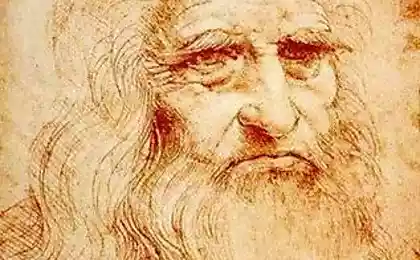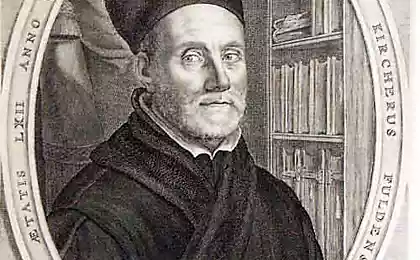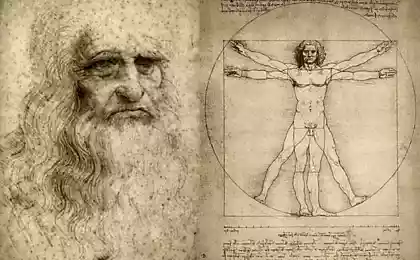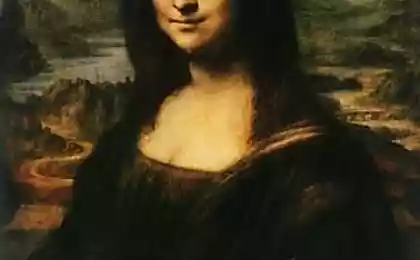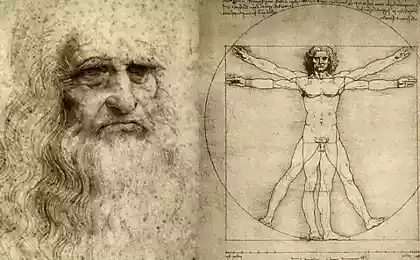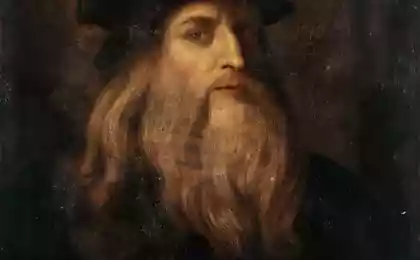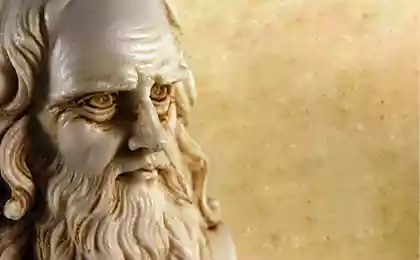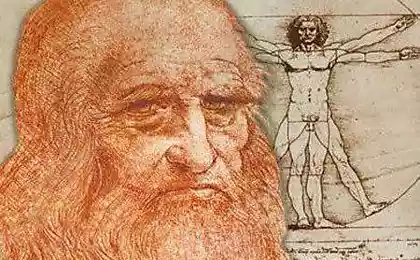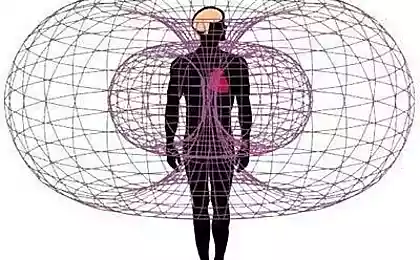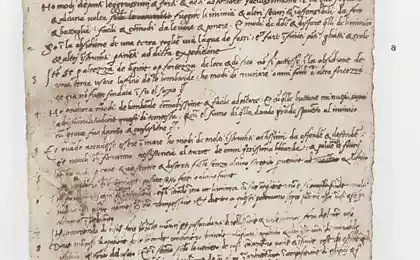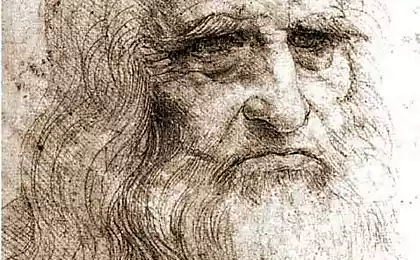450
Five secrets of Leonardo da Vinci
1. Leonardo a lot encrypted, so his ideas are revealed gradually, as mankind before they “ripen”. The inventor wrote with his left hand and incredibly small shaped as letters, and even right to left. But that is not enough all the letters he turned in the mirror image.
He spoke in riddles, sprinkled metaphorical the prophecies, loved to be rebuses.
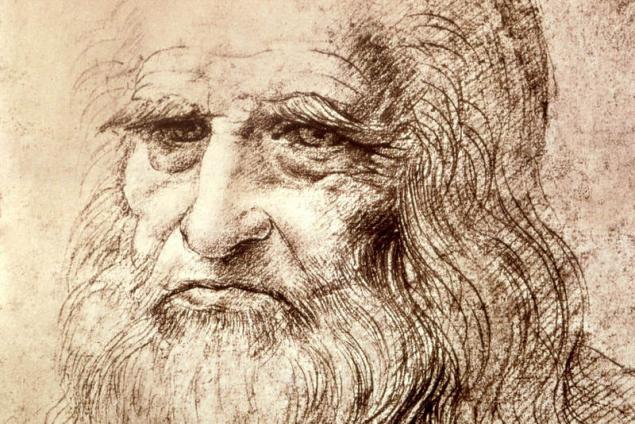
Leonardo did not sign their works, but they have markings. For example, if you look at the picture, it is possible to detect symbolic soaring bird.
These signs, apparently, a lot, so certain of his offspring suddenly discovered through the ages. As the Benois Madonna, which for a long time as the home icon took a group of traveling performers.
2. Leonardo invented the principle of dispersion (or sfumato). Objects on his canvases do not have clear boundaries: all, as in life, is blurred, penetrate one into the other, and therefore, breathes, lives, and awakens imagination. Italian advised to practice in such scattering, looking at emerging from the damp stains on the walls, ashes, clouds or mud. It is specially fumigated with smoke room, where he worked to the clubs to seek out images. Due to the effect of sfumato appeared the sparkling smile of the Mona Lisa, depending on the focus of the gaze of the viewer think that the character in the picture then gently smiles, predatory grins. The second miracle of the Mona Lisa that it is “live”. For centuries her smile changed, the corners of his lips rise above.
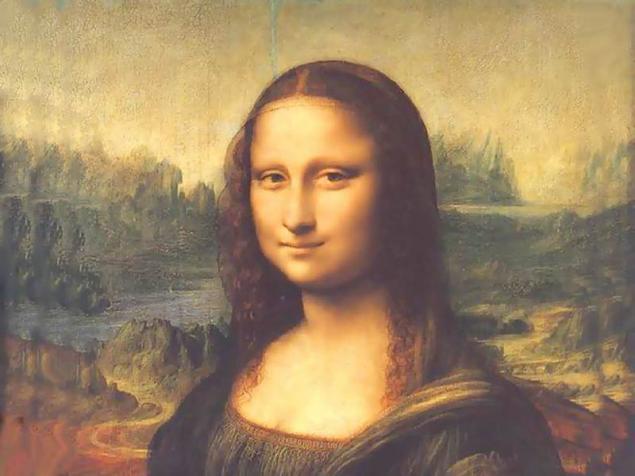
Similarly, the Master mixed knowledge of different Sciences, so his invention eventually find more and more applications. From the treatise of light and shadow occur the beginning of the Sciences of the penetrating force, oscillatory motion, wave propagation. All of his 120 books were scattered (sfumato) in the light and gradually open to mankind. 3. Leonardo preferred method of analogy to all others. Approximation of analogy is an advantage over the accuracy of the syllogism, when of two conclusions inevitably followed by the third. But one thing. But what a bizarre analogy, the further extend the conclusions from it. Look at the famous illustration of the Master, proving the proportionality of the human body. With outstretched hands and her legs spread, the figure of a man fits into a circle. And with her legs shut and raised his hands in a square, forming a cross.
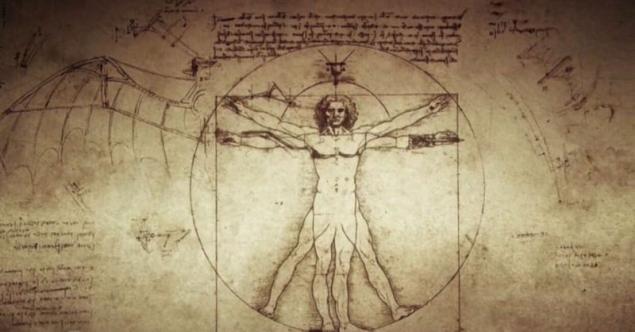
Such a “mill” gave rise to a number of different thoughts. Florentine was the one who went to the projects of churches, when the altar is placed in the middle (navel), and praying — evenly around. This Church plan in the form of the octahedron was another genius invention of the ball bearing. 4. Leonardo liked to use the rule of contrapposto — opposition of opposites. Contrapposto creates movement. Making a giant sculpture of a horse in the Corte Vecchio, the artist has placed the horse legs in contrapposto, which created the illusion of a special freewheel. Everyone who saw the statue, involuntarily changed their pace more relaxed. 5. Leonardo was never in a hurry to finish the work for neokonchennosti — binding quality of life. To finish means to kill! The slowness of the Creator was a byword, he could make two or three strokes and leave for many days out of the city, for example, to develop the valley of Lombardy, or to create a device for walking on water. Almost every one of his significant works are “unfinished”. Many were spoiled by water, fire, a barbaric appeal, but the artist did not correct them. The Master had a special composition, with whom he finished painting, especially if done the “window of incompleteness”. Apparently, he left the place where life itself could intervene to correct them.published
Also interesting: the Amazing coincidences of ancient civilizations Interesting facts about Ancient Egypt
Source: www.brainstorm-blog.ru/2014/09/blog-post_7.html
He spoke in riddles, sprinkled metaphorical the prophecies, loved to be rebuses.

Leonardo did not sign their works, but they have markings. For example, if you look at the picture, it is possible to detect symbolic soaring bird.
These signs, apparently, a lot, so certain of his offspring suddenly discovered through the ages. As the Benois Madonna, which for a long time as the home icon took a group of traveling performers.
2. Leonardo invented the principle of dispersion (or sfumato). Objects on his canvases do not have clear boundaries: all, as in life, is blurred, penetrate one into the other, and therefore, breathes, lives, and awakens imagination. Italian advised to practice in such scattering, looking at emerging from the damp stains on the walls, ashes, clouds or mud. It is specially fumigated with smoke room, where he worked to the clubs to seek out images. Due to the effect of sfumato appeared the sparkling smile of the Mona Lisa, depending on the focus of the gaze of the viewer think that the character in the picture then gently smiles, predatory grins. The second miracle of the Mona Lisa that it is “live”. For centuries her smile changed, the corners of his lips rise above.

Similarly, the Master mixed knowledge of different Sciences, so his invention eventually find more and more applications. From the treatise of light and shadow occur the beginning of the Sciences of the penetrating force, oscillatory motion, wave propagation. All of his 120 books were scattered (sfumato) in the light and gradually open to mankind. 3. Leonardo preferred method of analogy to all others. Approximation of analogy is an advantage over the accuracy of the syllogism, when of two conclusions inevitably followed by the third. But one thing. But what a bizarre analogy, the further extend the conclusions from it. Look at the famous illustration of the Master, proving the proportionality of the human body. With outstretched hands and her legs spread, the figure of a man fits into a circle. And with her legs shut and raised his hands in a square, forming a cross.

Such a “mill” gave rise to a number of different thoughts. Florentine was the one who went to the projects of churches, when the altar is placed in the middle (navel), and praying — evenly around. This Church plan in the form of the octahedron was another genius invention of the ball bearing. 4. Leonardo liked to use the rule of contrapposto — opposition of opposites. Contrapposto creates movement. Making a giant sculpture of a horse in the Corte Vecchio, the artist has placed the horse legs in contrapposto, which created the illusion of a special freewheel. Everyone who saw the statue, involuntarily changed their pace more relaxed. 5. Leonardo was never in a hurry to finish the work for neokonchennosti — binding quality of life. To finish means to kill! The slowness of the Creator was a byword, he could make two or three strokes and leave for many days out of the city, for example, to develop the valley of Lombardy, or to create a device for walking on water. Almost every one of his significant works are “unfinished”. Many were spoiled by water, fire, a barbaric appeal, but the artist did not correct them. The Master had a special composition, with whom he finished painting, especially if done the “window of incompleteness”. Apparently, he left the place where life itself could intervene to correct them.published
Also interesting: the Amazing coincidences of ancient civilizations Interesting facts about Ancient Egypt
Source: www.brainstorm-blog.ru/2014/09/blog-post_7.html
